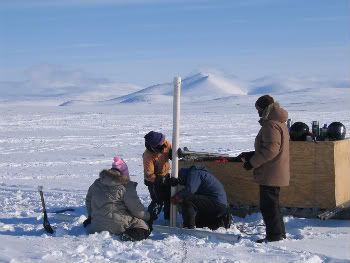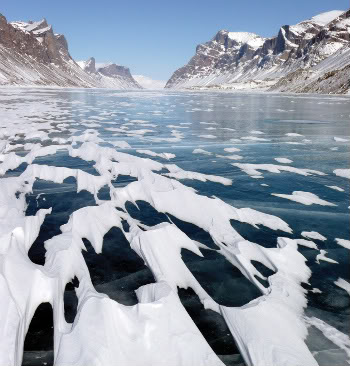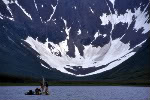Arctic researcher: ‘we have entered unchartered territory’
The Arctic should be growing cooler, but a new sediment core taken from an Arctic lake reveals that the lake’s ecology and chemistry has been transformed by unnatural warming beginning in the 1950s. The sediment core proves that changes happening in the lake during the Twentieth Century are unprecedented over the past 200,000 years.
Headed by University of Colorado scientist Yarrow Axelford, the study retrieved the sediment core from the bottom of a thirty foot deep lake on Baffin Island. Importantly the sediment core goes back 80,000 years further than any other core retrieved from the Greenland ice sheet, providing researchers with the longest timescale yet of changes in the Arctic climate.
 A University of Colorado at Boulder-led analysis of a 200,000 year-old sediment core from a Baffin Island lake indicates warming temperatures in the Arctic due to human activity are overriding a natural cooling trend in the region. Photo by: Jason Briner. |
“What is unique about these sediment cores is that even though glaciers covered this lake, for various reasons they did not erode it,” said study co-author Jason Briner of the University at Buffalo. “The result is that we have a really long sequence of sediment that has survived Arctic glaciations.”
Sediment cores provide data for scientists on chemical conditions, and ecology through fossilized insects and algae. Examining such fossils, the team was able to reconstruct past climates and found that changes in species and lake-water chemistry were tightly linked to past climatic shifts.
For example, cold-loving midges have survived in the lake for the past thousand years, but beginning in the 1950s the midges began to dwindle. Two of the midge species, especially adapted for extreme cold, have since vanished entirely due to their inability to survive in a warmer ecosystem. The sediment core also showed that a type of lake algae, called a diatom, was rare until the Twentieth Century when its population suddenly boomed: the scientists believe the diatom’s success could be due to declining ice on the lake. Such findings are unprecedented.
 The adjacent foothills hold lakes that were not scoured by glaciers during late Quaternary glaciations, and thus preserve exceptionally long sedimentary records of climate change. Photo by: Jason Briner. |
“The 20th century is the only period during the past 200 millennia in which aquatic indicators reflect increased warming, despite the declining effect of slow changes in the tilt of the Earth’s axis which, under natural conditions, would lead to climatic cooling,” says Axford.
John Smol, of Queen’s University and winner of the 2004 NSERC Herzberg Gold Medal as Canada’s top scientist, warned that “this historical record shows that we are dramatically affecting the ecosystems on which we depend. We have started uncontrolled experiments on this planet, and we have entered unchartered territory. The situation is far worse than we thought and this is only the beginning.”
Funded by the National Science Foundation, the Natural Sciences and Engineering Research Council of Canada and the Geological Society of America, the study included researchers from Colorado University-Boulder, New York’s University at Buffalo, the University of Alberta, the University of Massachusetts, and Queen’s University in Ontario.
Related articles
Sea levels set to rise as Arctic warming replaces millennia long natural cooling cycle

(09/03/2009) According to a new study published in Science the Arctic should be cooling, and in fact has been cooling for millennia. But beginning in 1900 Arctic summer temperatures began rising until the mid-1990s when the cooling trend was completely overcome. Researchers fear that this sudden up-tick in temperatures could lead to rising sea levels threatening coastal cities and islands. “Scientists have known for a while that the current period of warming was preceded by a long-term cooling trend,” said lead author Darrell Kaufman of Northern Arizona University. “But our reconstruction quantifies the cooling with greater certainty than ever before.”
NASA reveals dramatic thinning of Arctic sea ice

(07/07/2009) Arctic sea ice thinned dramatically between the winters of 2004 and 2008, with thin seasonal ice replacing thick older ice as the dominant type of sea ice for the first time on record, report NASA researchers. Scientists from NASA and the University of Washington used observations from NASA’s Ice, Cloud and land Elevation Satellite (ICESat) to make the first Arctic Ocean basin-wide estimate of the thickness and volume of sea ice cover. The researchers found that overall Arctic sea ice thinned about 17.8 centimeters (7 inches) a year, for a total of 67 cm (2.2 feet) over the four winters from 2004 to 2008. The total area covered by thick older ice that survives one or more summers (“multi-year ice”) shrank 42 percent or 1.54 million square kilometers (595,000 square miles), leaving thinner first-year ice (“seasonal ice”) as the dominant type of ice in the region.
Arctic ecosystem in danger as ice thins

(04/07/2009) Recent dramatic news points to both poles undergoing transformation due to climate change. This weekend an ice bridge disintegrated on the Wilkins Ice Shelf in Antarctica, leaving the whole shelf vulnerable to melting, and then yesterday new evidence was released of the impact of warming in the Arctic. Younger thinner ice has become the dominant type in the Arctic over the past five years, reports a new study led by Research Associate Charles Fowler of the Colorado Center for Astrodynamics Research. The thinner ice does not bode well for the Arctic ecosystem, as the ice is more prone to summer melting.